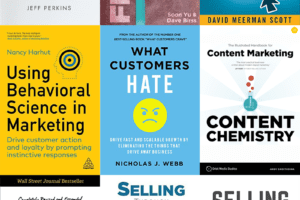What can you learn about executive presence, personal branding, and developing a talent pipeline from the world of acting? A lot.
Carol Lempert is an actress, keynote speaker, executive coach, consultant, and playwright, among other things, and she helps leaders apply lessons from the stage to improve their executive presence and communication.
On this episode, Steve’s interview with Carol covers a variety of fascinating insights from the boardroom, the theater, and even the lab:
- How stories literally sync our brainwaves
- What great actors and great leaders have in common
- The percentage of people who don’t know what their personal brand is (and how to figure it out)
- The two parts of every meeting
- Her top piece of advice for a successful first impression
- Why Sarah Silverman is awesome
Tap through the chapters above to listen or skim our summary of the highlights below. Want to see the full interview, including Carol’s live tips for having better presence over Zoom? View the conversation on our podcast page.
Guest-at-a-Glance
???? Name: Carol Lempert
???? What she does: Virtual speaker and trainer, executive coach, writer, and actress.
????️ Find Carol on the web: Website | LinkedIn | Twitter
???? Get smart: “Stories sync up brainwaves.”
Top Takeaways
3 questions to ask to learn what your personal brand is ????
“When you don’t know what your brand is,” Carol says, “you don’t know that your own brand might be sabotaging what it is that you’re trying to do.” She gives a few examples of executives she’s worked with who didn’t realize how their personal brands were getting in the way of their own individual professional goals. She also shared the three questions she has her clients ask their colleagues to help them establish what their brand currently is, so they can determine whether it’s helping or hindering them in what they want:
- What six words would you use to describe me?
- What drives you crazy about me?
- What do you think is getting in the way of my success?
Think you already know what your personal brand is? Think again: Carol cites a Forbes study which found that 70 percent of the professionals they surveyed thought they know the adjectives their colleagues would use to describe them, but only 15 percent of those people were actually right.
How to establish your executive presence virtually ????
Carol gives a number of actionable tips for showing up as high potential, promotable leader in a virtual or hybrid world.
???? Turn on your camera: “If you’re not being seen, you’re signaling to people ‘This hour of my life with you is not that important to me,’ Carol says. “But also, you’re missing an opportunity to show your boss that you care about what’s going on.”
???? Look where the camera is: Often, your camera will be indicated by a green dot on your monitor. Instead of looking at the person who is talking or at something else on your screen, talk directly to your audience by keeping your focus on the camera.
“If I’m running a meeting and the person at the bottom of my screen is talking and I’m having a whole conversation with the person down there, everybody else in the meeting won’t be paying attention,” she explains. She suggests putting a Post-It note—or even a pair of googly eyes—above your monitor’s camera to remind you where to look.
???? Be aware of your posture: Carol shows the difference between someone leaning back in their chair looking disengaged, and someone who is physically leaning forward and being present in the meeting.
???? Don’t multitask: “If you are answering your email while you are attending the meeting, you are not mentally present and people will know that you’re not mentally present,” Carol says.
“That’s going to impact your relationship with them, and you’re probably going to miss something important that you’re going to have to ask a question about later, and that’s going to tick people off.”
Episode Highlights
An actor’s strengths are a leader’s strengths
“At the beginning of my executive presence workshops, everybody tells me an actor or an actress that they like, and they tell me why, and we make a big list of all of those skills. So your words [about Sarah Silverman] were differentiator, authenticity, being really bold, willing to make people uncomfortable so that new ideas can be absorbed into their brain. …So, that big, long list of skills and attributes are exactly the skills and attributes that leaders need.”
Why she teaches her clients to breathe
“Breathing gets you in the moment, and when you’re in the moment, your anxiety fades away and it is your anxiety that is often the biggest sabotager.
If you’re thinking about the past too much, that’s the road to depression. So if you’re coming into any kind of meeting or conversation or job interview, for example, thinking about, ‘Ooh, the last time I did it, it didn’t go so well’ — that’s the road to depression, so you’re going to show up a little sad.
And if you’re worried about, ‘Ooh, what’s going to happen tomorrow when I’m done, what is my boss going to think about me? Am I going to get that promotion? I’m having a meeting today and my performance review is in three weeks, this meeting is really going to weigh into what my…’ — that’s all future thinking. Future thinking is the road to anxiety.
…You have to be the moment that you’re in.”
Host a better virtual meeting
“Prime the pump for active listening. Before you share your PowerPoint slides, say to your team, ’As I go through this deck, what I want you to be thinking about is…’ And it could be, how our customers might experience this new idea, how the marketing department or how the it department might be thinking about this new idea, where might we get future growth with this new idea…
So prime the pump for how it is you want people to engage with the material at the beginning, and then add, ’As I’m presenting, please use the chat bubble and as I’m going through the presentation, jot down your thoughts and your questions and reactions.’
And then you can either do option A, which is, ’At the end of the presentation, I’m going to say to everybody, press send on the chat and the chat will explode and then I’ll go through all of those things,’ or option B, ‘You can send those thoughts and questions as I’m going through and I’ll respond to them as they come.’”
The two parts to every meeting
“There’s two parts to any meeting. There’s the content, ‘here’s the information we need to talk about,’ and there’s the relationship. And relationships are not static things. Every time you have an interaction with another human being, whether it’s virtual or actually in person, one of three things will happen:
- You will feed the relationship and make it stronger because you’ve involved people, you’ve asked their opinion, you’ve acknowledged what they’ve added.
- Nothing will happen. It’s transactional. That’s not bad, but it’s also not good. And you’re not leveraging your face time with people to improve relationships and create a team expense.
- Or you starve the relationship because people start to feel excluded. They start to feel that they don’t have a way to add what’s going on.”
Stop being your own IT person
“[In a theater production] there’s a stage manager, there’s a lighting person, there’s a sound person, there’s a wardrobe person—there’s a whole big team that has all of these other tasks to make the production be successful. So what you can do is replicate those roles in a virtual environment.
Professionals who use technology have backstage people and they have on-camera people. So I’m going to assign one person on my team to be in charge of the chat and they’ll tell me when all the questions come. I can have another person on my team be in charge of making sure if people drop out of the call, that they can get back in so that we’re not all waiting around five minutes for George to sign back in. You can assign those kinds of tasks so that you, as the person facilitating the meeting, can facilitate the meeting. Give somebody a job and then they’re involved. ”
How stories sync up brainwaves
“They’ve done some studies about the power of storytellers and story listeners. So when they put fMRI cams on top of storytellers and they put fMRI cams on top of story listeners, if I read to you all of the metrics of the organization—let’s say you’re talking about users on your website, ‘we have so many users,’ ‘our goal next year is to have this many more users’—the audience’s brainwaves are sort of chaotic.
The minute that the presenter transitions to telling a story of a single user experience, and telling the story of a woman named Joan who lives in Duluth and she’s interested in our foot care product because her son has a problem with his foot, a miraculous thing starts to happen. Stories sync up brainwaves, so the brainwaves of the story listeners start to sync up with the brainwaves of the storyteller.
What leaders want to do is get buy-in to their ideas and influence thinking. So we have scientific evidence that says, when you tell a story, you literally are shaping other person’s brain into your brain. Their brainwaves are literally syncing up with your own brainwaves.”
Make storytelling a habit
“Whenever you’re looking at your metrics, remember that those metrics represent human behavior and think about the example of the singular—the person that you can talk about that is represented by what all of these statistics are.”
Top Quotes
????️ Carol:
“Your first impression is where the brand starts.”
“You need to figure out, ‘Is my current brand working for me in terms of what my current goals are?’”
“One of the skills I teach is listening to the end and don’t formulate your answer while the person’s still talking.”
“Deepening relationships is acknowledging the humanity that’s in the room, and it’s difficult to acknowledge the humanity that’s in the room if you’re not paying attention to the actual human beings that are part of the conversation.”
“The heart of executive presence is the word present—to be present.”



